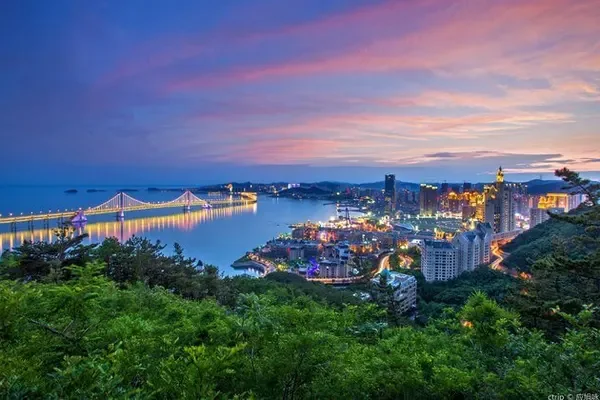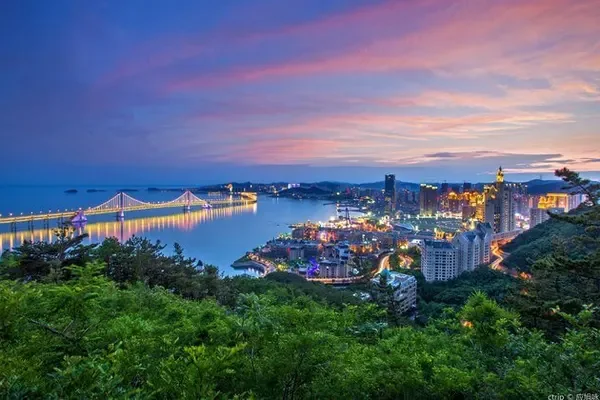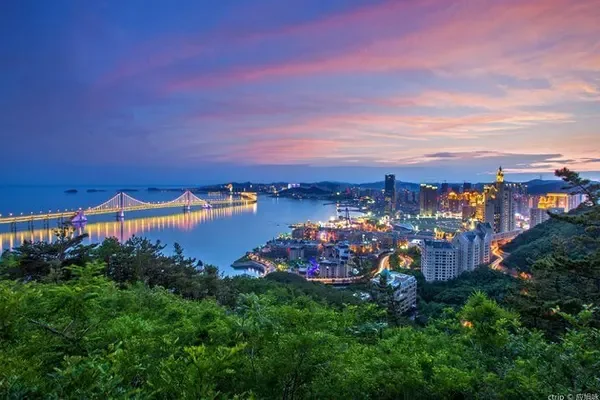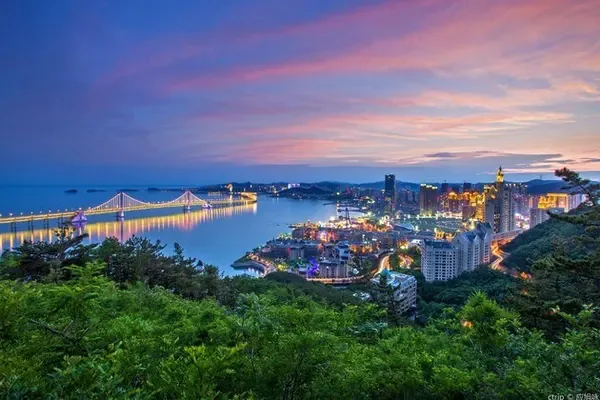When mentioning the city of Chengde, the first thing that comes to mind is the Summer Resort. A mountain villa, half of Qing history. Its status is like that of the Forbidden City in Beijing and the Oriental Pearl Tower in Shanghai. The history of Chengde, also called Rehe, has a specific regional culture and profound heritage. As everyone knows, it must have been built in the 42nd year of Kangxi in the Qing Dynasty and finally completed in the 55th year of Qianlong. It took 87 years for this summer resort. It is the place where the emperors of the Qing Dynasty escaped the summer heat and dealt with government affairs. It is a famous ancient imperial palace.
Chengde Mountain Resort is located in the north of Chengde City and is surrounded by the Outer Eight Temples. The picture below is the main entrance of the Summer Resort, that is, the main entrance of Nanmenli. Many tourist groups and individual tourists will enter through this door. Therefore, the traffic situation near Lizhengmen is a bit worrying, and the food and accommodation are relatively expensive.

The current ticket for the Mountain Resort is 130 yuan. It is divided into four major areas: the palace area, the lake area, the mountain area, and the plain area, among which the palace area and the lake area are the essence of the summer resort. After entering through Lizhengmen, you will first arrive at the Summer Resort Museum. You must listen to the tour guide’s explanation in this part of the palace area. There may be a historical story behind a stone tablet, a calligraphy and painting, and a table and chair. A lot of the fun will be lost.



After passing through the palace area, you come to the fork of the mountain and lake area. It is worth mentioning that if you plan to spend a day in the summer resort, you can go to the mountains. It is necessary to take a scenic sightseeing bus in the mountainous area, because the area of the mountainous area is too large, and it takes an hour for the sightseeing bus to drive around. The fare of the sightseeing bus is 50 yuan. Of course, friends who like to hike or have enough time and physical strength will discuss it separately. The mountain sightseeing car will stop at three scenic spots in the middle, and the second stop that must be got off is the Erma Road. Get off here If the weather is fine, you can overlook the Little Potala Palace on the opposite side of the mountain.

If you don't want to visit the mountains, the lake area is also the essence of the summer resort. There are also sightseeing cars and cruise ships in the same scenic spot. However, it is recommended to browse the Lake District on foot. Tourist maps of the scenic spot can be seen everywhere at the intersections in the scenic spot, which is more convenient, and you can visit around the lake according to your physical strength and time.



If you ask which place in the Summer Resort is the most famous, it is the Yanyu Building on Huxin Island. The filming location of "Returning the Pearl" back then, the little swallow Zhao Wei fell from the tree was also filmed here, and it was the original tree. It’s just that you try to avoid the peak flow of people here, otherwise you won’t feel anything, it will be full of people.

Wenjinge is the place where Siku Quanshu was compiled, but unfortunately it was not open when I went.

Located in the north of the Mountain Resort, Yongyou Temple was first built in the 16th year of Qianlong (1751). "Yongyou" is the largest temple among the nine temples in the mountain resort, facing south. Most of the halls in the temple have been destroyed, and only the stele and the tower in the picture below remain. This pagoda is built in imitation of the Pagoda of Baoen Temple in Nanjing and the Pagoda of Six Harmonies in Hangzhou. The top of the pagoda is gold-plated and not painted, which is in harmony with the style of the villa. I like the color of the pagoda very much.


Jinshan Island is an artificially piled rockery in the northeast of the lake area. It is combined with the real mountain to form a stone stepping path, with staggered teeth and jagged rocks. Surrounded by lakes on three sides, it faces deep ravines on one side. To the north is the endless grass and trees on the plain, and to the southwest is the open lake. The sky is bright and cloudy, and the clear water is floating in the air. It is refreshing to watch. There is a temple in the south called "Tianyu Xianchang". Its site is located at the end of the climbing corridor on the west side, and meets the stone-stepped road on the east side. There is a platform at the meeting place, and a three-room temple with a width of 3 rooms was built here. .
The highest place in the picture below is the main God Pavilion. The guide who passed by said that walking around it four times is for luck.


The picture below is one of the representative landscapes of the Summer Resort. It is said that when the CCTV weather forecast broadcasts Chengde, the picture is here.


The entire Summer Resort is really too big, with a total area of 5.64 million square meters. It will take at least a whole day. It took me half a day to abandon the mountainous area and some scenic spots such as the open Lion Forest, which is a pity. Therefore, I suggest that you stagger the tourist season, choose a day to stroll here, and experience the summer life of the emperor face to face.
Just north of the Summer Resort is the Putuo Zongcheng Temple, known as the Little Potala Palace. It is the most famous of the eight outer temples. Chengde Outer Eight Temples refers to the twelve Lamaism temples built around the Chengde Mountain Resort in the Qing Dynasty in the form of Tibetan, Xinjiang, and Mongolian Lamaism temples. Because eight temples are under the jurisdiction of the Qing government, they are commonly known as "Outer Eight Temples". The picture below is the gate of Putuo Zongcheng Temple. Tickets and the Temple of Sumeru Fushou total 80 yuan. There is a scenic free shuttle bus between the two scenic spots.

There are also a lot of tourists in Putuo Zongcheng Temple. Friends who can't go to Tibet can experience the architecture and charm of Tibetan Buddhism here.


Standing on the huge red wall are the body of the tower, the tripod, and the prayer flags. You can follow the tour guide to explain, listen to the allusions, and many knowledge points.



Climbing to the top of the temple is just to take a look at the legendary golden dome. The roof is really inlaid with gold.



After visiting the Putuo Zongcheng Temple in about two hours, there is a free shuttle bus to the scenic spot when you go out, and you will arrive at the Xumi Fushou Temple next to it in two minutes. There is a free guide at the entrance of the Xumi Fushou Temple, and you can follow along, but at the end of the talk, you will still kindly persuade you to buy some things, but it is all voluntary, after all, this is a formal national tourist attraction.

The same golden dome, different golden dragon. Each golden dragon on the roof of Fushou Temple is said to weigh a ton.



The highest point of the Xumi Fushou Temple is a pagoda, which cannot be climbed to the top. Walk around the pagoda. The mottled murals and stone statues on the pagoda highlight the vicissitudes of this temple. The heavy feeling tells the experience of wind and rain. .

Whether you are in the Summer Resort, the Little Potala Palace, or even the streets in the urban area, you can see a huge boulder shaped like a mallet standing on the mountain from a distance. This is the local Qingchui Peak, commonly known as Bangchui Mountain among the people. The ticket for the scenic spot is 80 yuan, including Pule Temple and Anyuan Temple in the Outer Eight Temples next to Qingchui Peak.
When approaching the entrance of Qingchuifeng Park, there will be local people stopping cars on the side of the road, claiming that tourists can be brought into the scenic spot from the back mountain, and private cars can be driven halfway up the mountain. There is indeed such a thing, which saves time for climbing the mountain. I drove away from the main entrance of the scenic spot for about 20 minutes, passed a dilapidated village road in Hamashi Village, parked the car in a "parking lot" that is not a parking lot, and handed over to the local villagers 20 yuan to park After paying the fee, walk for about 10 minutes to reach the foot of "Bandhammer". The guide fee can be negotiated, even without buying tickets, it is also possible to give the ticket fee to the guide. However, I recommend buying your own tickets first. Because the guide is only responsible for bringing you into the Qingchuifeng Forest Park Scenic Area, and this ticket also includes Pule Temple and Anyuan Temple, you give the ticket money to the guide, and he will not give you a regular ticket, just take you in After the Qingchuifeng Scenic Area, you will not be able to go to Pule Temple and Anyuan Temple.

If you buy tickets from the gate of the scenic spot and go in to play, you can choose to take the cable car or climb the mountain on foot. Qingchui Peak Cableway is currently the second longest chair-type cableway in the country, with a length of 1,620 meters. It is estimated that it will take about 1 hour to climb up.

After arriving at Bangchui Peak, it is not far from Hama Rock, but it is a pity that it is better to look at it from a distance when it is close, as it does not look like a toad at all. At present, Bangchui Peak and Hama Rock are surrounded and cannot be touched. In the past, there was a saying in the local area called "Touch Bangchui Mountain, and you can live a hundred and thirty years".

Out of the Qingchuifeng Forest Park Scenic Area. There are two zigzagging mountain roads on the left and right of the parking lot at the gate, and there are signposts on each. One road leads to Pule Temple. It takes about ten minutes to walk up. You can also drive to the gate of Pule Temple. The parking fee is 10 yuan.

Compared with the overcrowding of the Little Potala Palace, Pule Temple is relatively quiet. The architectural layout of Pule Temple is divided into two parts, the front and the back. The front part is the traditional form of Han temples from the mountain gate to the Zongyin hall. Emperor Qianlong adopted the suggestion of Zhangjia, the living Buddha of Tibet, and built the temple in 1766. It was named "Pule" after the meaning of "worry about the world's worries first, and enjoy the world's joy later".

Then there is a platform, on which Xuguang Pavilion is built, imitating the shape of the Hall of Prayer for Good Harvest in the Temple of Heaven in Beijing. The whole temple is not big, and it takes 40 minutes to return the same way.


Going up another mountain road from the parking lot at the gate of Qingchuifeng Forest Park is Anyuan Temple. Also walk for about ten minutes, private cars can also drive to the gate of Anyuan Temple, the parking fee is 10 yuan. If you are not a believer in Buddhism, or have obsession with the Eight Foreign Temples, you can actually come to Anyuan Temple. The entire temple building is still magnificent and sacred, but it is the only building that burns incense and worships Buddha. The tour can be completed in half an hour at most.



The scale of Puning Temple is relatively large, and some Buddhist activities in Chengde will still be held here. Tickets for Puning Temple are sold separately for 80 yuan. Puning Temple was originally built as a Han-Tibetan temple during the Qianlong period of the Qing Dynasty. The first half of the temple is in Han style, which has the characteristics of traditional Han Buddhist temples; the second half is in Tibetan style, imitating the Sangyuan Temple in Tibet, and the two different styles of buildings are integrated into one.


Mahayana Pavilion is the central building of Puning Temple, with four Lama pagodas of different colors at the four corners. The Mahayana Pavilion is 36.75 meters high, with 6 floors of double eaves on the front. There is a standing statue of Avalokitesvara Bodhisattva with thousands of arms and eyes inside the pavilion. This Buddha with thousands of hands and eyes is also the largest wooden Buddha statue in China. Since no photos are allowed in the hall, there are no photos left.


After passing through the Mahayana Pavilion, there are Tibetan Buddhist buildings. In order to commemorate the two victories against the rebellion, Qianlong built a royal temple of the Qing Dynasty in the north of the villa, imitating the Sangyuan Temple in Tibet because the Qing government believed in Tibetan Buddhism.

Even if you don't have the heart to visit the Buddhist temple, just to look at the building, it must be a worthwhile trip.


The breeze blows, the Sanskrit sounds sound, and the heart will be washed and quieted down.


The Puyou Temple in the Outer Eight Temples is also here, connected to the Puning Temple, but the Puyou Temple has been severely damaged, and currently only the Arhat Hall and the main hall remain.

If you visit the above scenic spots in Chengde city, it will take about two or three days. The most important thing is to see how to arrange the summer resort, whether to take a stroll in the garden or just listen to the explanation along the central axis. It takes at least one and a half days to visit the Outer Eight Temples and Qingchuifeng Scenic Spots. In addition, there are Shuxiang Temple and Puren Temple in the Outer Eight Temples, which are not open. The rest of Jinshanling Great Wall and Shuangtashan Scenic Area depend on their respective schedules.
When you travel to Chengde, you can feel the historical footsteps of a mountain city outside the Great Wall that rose from gardens and a group of temples, and you can feel the prosperity and decline of the last feudal dynasty.
I have more travel notes and photos, in my button space 294977050, all interested friends can read, if you have any travel questions, you can communicate together



